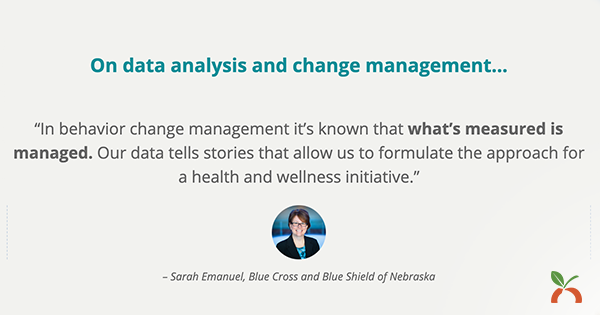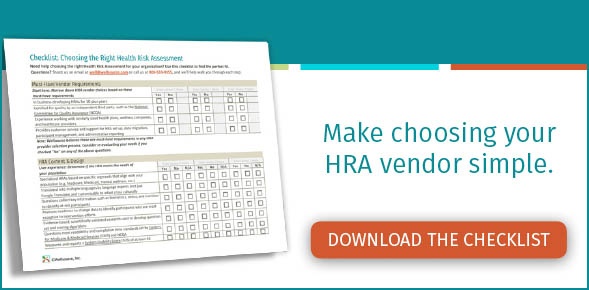In partnership with the Population Health Alliance (PHA) we recently hosted a webinar on the importance of standardizing what makes for quality data, how to ensure quality in the data analysis processes, and the role of trust in gathering self-reported health and lifestyle data. Our panel of speakers included Wellsource's very own CEO Chris McReynolds, along with Natalie Mueller, Senior Product Development Manager at NCQA, and Sarah Emanuel, Manager, Wellness Services at Blue Cross Blue Shield of Nebraska.

The discussions around what makes for quality data and the inherent challenges of a commitment to quality within a population health program brought was jam-packed with important insights and information. For a high-level view into the conversation, we’ve chosen our top 5 quotable moments below.
On the importance of standardization within the pursuit of quality HRA data collection...
“Standardization is a key foundation for improving quality. It creates a level playing field. One of our challenges is to create those standards while allowing for flexibility to serve different population types.” |
 |
|
Natalie Mueller, NCQA
|
This insight from Natalie with the NCQA came while discussing the importance of standardization in achieving quality results. As a leading organization in health plan accreditation, NCQA is all about improving the quality of health care, and that starts with creating standards around processes and structures. Natalie also noted that, in allowing for flexibility, the NCQA also accepts adapting these standards and being open to change as new, better evidence or best practices emerge.
Related content: Wellsource Proves Commitment to Quality, Excellence by Achieving NCQA Certification for the 12th Consecutive Year. Read more...
|
On data analysis and change management...
“In behavior change management it’s known that what’s measured is managed. Our data tells stories that allow us to formulate the approach for a health and wellness initiative.” |
 |
|
– Sarah Emanuel, Blue Cross and Blue Shield of Nebraska
|
This statement from Sarah with Blue Cross and Blue Shield of Nebraska (BCBSNE) was in response to the question, how do we ensure quality in how we analyze our data. Sarah detailed how rigorous the BCBSNE's policies for delivery of health promotion initiatives are, aimed at empowering members to take charge of their health.
When working with Wellsource to administer an HRA, every consideration is taken to ensure a quality and secure experience for participants, including how members receive access to an HRA tool, what information is collected, reporting that allows the participant a better view into their health, and suggested activities to improve their health. This entire process is vetted by an internal quality management committee comprised of clinical professionals, and in administering the HRA, privacy and security measures are in place to protect personal health information.
|
On the reliability of self-reported data, and accounting for bias in data analysis...
“The first step is recognizing it’s there. We aren’t going to kid ourselves and say there’s a way to eliminate bias from our data. But by using evidence-based questions, data structures and other proven methods, we can minimize and account for bias within program design and structure.” |
 |
|
– Chris McReynolds, Wellsource
|
Increasing the reliability of health data and improving health outcomes is a topic Chris has written about in the past. Addressing limitations in any dataset is a first step toward this goal. However, there are some data points that can only be gathered using self-reported lifestyle data, and mitigating any bias requires building a trustworthy experience for participants and adhering to standards in how data is collected, analyzed, and used in population health programs.
|
On which metrics are important to track in the pursuit of high-quality data...
“Instead of random acts of wellness or doing things that seem as though they ought to be done, we are really grounding our programs within the metric. As a practitioner, you utilize a tool that has been evaluated, using data standards available in those best practice approaches.” |
 |
|
– Sarah Emanuel, Blue Cross and Blue Shield of Nebraska
|
For Sarah and BCBSNE, metrics set the stage for their population health programs. They identify what they want to measure and why, and then set goals for year over year improvements to track their efforts with a purpose. She continued to explain that reporting capabilities they look for within an HRA including a certain flexibility, allowing them measure beyond specific health risks, with HRA data that helps them better understand a participant's overall, holistic wellbeing.
|
On inciting change from the top down to encourage standardization across an organization...
“Over the years we’ve worked with a lot of health plans, and the ones who have done this well—the change is coming from leadership. Whether you’re going to sit back and let someone else lead the charge or you’re going to push things forward and raise the bar comes down to the intestinal fortitude of the leaders. At Wellsource, we talk a lot about the fact that we aren’t doing these things to check a box. Even if tomorrow a requirement were to be eliminated from NCQA, we would still be doing things this way because we believe this is important work.” |
 |
|
– Chris McReynolds, Wellsource
|
Once you've committed to creating a high quality population health program, you must ensure your HRA vendor also embodies excellence in gathering and analyzing population health data. Download our helpful checklist for Choosing the Right Health Risk Assessment and evaluate your options today.








